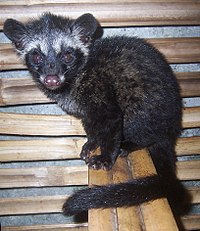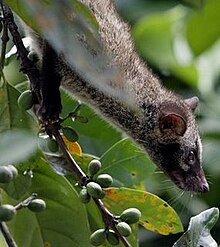Asian palm civet: Difference between revisions
Extended confirmed users, Pending changes reviewers 53,965 edits m fixed typo |
Extended confirmed users, Pending changes reviewers 53,965 edits →Description: revised with ref |
||
| Line 21: | Line 21: | ||
== Description == |
== Description == |
||
The Asian Palm Civet |
The Asian Palm Civet is a small mottled gray and black viverrid weighing {{convert|2|to|5|kg|lb|abbr=on}}.<ref name="grassman98">Grassman Jr., L. I. (1998) ''Movements and fruit selection of two Paradoxurinae species in a dry evergreen forest in Southern Thailand.'' Small Carnivore Conservation 19: 25-29.</ref> It has a body length of {{convert|53|cm|in|abbr=on}} and a tail length of {{convert|48|cm|in|abbr=on}}. Its long, stocky body is covered with coarse, shaggy hair that is usually greyish in color, with black on its feet, ears and muzzle. It has three rows of black markings on its body. The markings on its face resemble a [[raccoon]]'s. Its tail does not have rings, unlike similar [[civet]] species. |
||
==Distribution and habitat== |
==Distribution and habitat== |
||
Revision as of 17:35, 10 December 2010
| Asian Palm Civet[1] | |
|---|---|

| |
| juvenile | |
| Scientific classification | |
| Kingdom: | |
| Phylum: | |
| Class: | |
| Order: | |
| Family: | |
| Genus: | |
| Species: | P. hermaphroditus
|
| Binomial name | |
| Paradoxurus hermaphroditus (Pallas, 1777)
| |
The Asian Palm Civet is a small member of the
Description
The Asian Palm Civet is a small mottled gray and black viverrid weighing 2 to 5 kg (4.4 to 11.0 lb).[3] It has a body length of 53 cm (21 in) and a tail length of 48 cm (19 in). Its long, stocky body is covered with coarse, shaggy hair that is usually greyish in color, with black on its feet, ears and muzzle. It has three rows of black markings on its body. The markings on its face resemble a raccoon's. Its tail does not have rings, unlike similar civet species.
Distribution and habitat


Asian palm civets are native to
Ecology and behaviour
Feeding and diet
The Asian Palm Civet is a
In most parts of Sri Lanka, civets are considered a nuisance since they litter in ceilings and attics of common households, and make loud noises fighting and moving about at night, disturbing the sleep of the householders.
Behavior
Asian Palm Civets perform scent marking using anal glands, urine, and feces. The most common marking behavior is dragging the anal glands on a surface to leave a scent. They are able to identify animal species, sex, and whether the individual who left the scent is known or unknown by smelling an anal scent secretion.[6]
Palm Civets are exclusively nocturnal, usually active between 6:00 pm and 4:00 am, being less active on nights when the moon is brightest.[4]
Names
The species' scientific name (Paradoxurus hermaphroditus), was given in 1777 because both sexes have scent glands underneath the tail that resemble testicles. Civets spray a noxious secretion from these glands.
The species is also commonly known as the Common Palm Civet or the Toddy Cat. Local names are:
- Musang or Alamid in the Philippines;
- Motit in the Gran Cordillera Central mountain range of northern Philippines;
- Marapatti or "മരപ്പട്ടി", translates as 'tree-dog' or 'wood-dog', in the indigenous language of southern India;
- Maranai in Tamil, also meaning 'tree-dog' or 'wood-dog'
- Uguduwa in Sinhala of Sri Lanka;
- Luwak in Indonesia, where Kopi Luwak, an expensive type of coffee, is produced.
Interactions with humans
Oil extract
The oil extracted from small pieces of the meat kept in linseed oil in a closed earthen pot and regularly sunned is used indigenously as a cure for scabies.[7]
Coffee
SARS
The
Subspecies
There are a significant number of subspecies of this civet:[1]
- P. h. balicus
- P. h. bondar
- P. h. canescens
- P. h. canus
- P. h. cochinensis
- P. h. dongfangensis
- P. h. enganus
- P. h. exitus
- P. h. hermaphroditus
- P. h. javanica
- P. h. kangeanus
- P. h. laotum
- P. h. lignicolor
- P. h. milleri
- P. h. minor
- P. h. musanga
- P. h. nictitans
- P. h. pallasii
- P. h. pallens
- P. h. parvus
- P. h. philippinensis
- P. h. pugnax
- P. h. pulcher
- P. h. sacer
- P. h. scindiae
- P. h. senex
- P. h. setosus
- P. h. simplex
- P. h. sumbanus
- P. h. vellerosus
See also
- Small Indian Civet
- Malabar Large-spotted Civet
- Masked Palm Civet
References
- ^ OCLC 62265494.
- ^ a b c Template:IUCN
- ^ Grassman Jr., L. I. (1998) Movements and fruit selection of two Paradoxurinae species in a dry evergreen forest in Southern Thailand. Small Carnivore Conservation 19: 25-29.
- ^ doi:10.2307/1382613. Retrieved 2009-11-18.)
{{cite journal}}: Check date values in:|date=(help); Unknown parameter|coauthors=ignored (|author=suggested) (help - ^ Thohari, M. (9–11 May 1984). "A preliminary study on the role of civet (Paradoxurus hermaphroditus) in the natural regeneration of palms (Pinanga kuhlii and P. zavana) at Gunung Gede-Pangrango National Park, West Java (Indonesia)". Symposium on Forest Regeneration in Southeast Asia. Bogor (Indonesia).
{{cite conference}}:|access-date=requires|url=(help); Unknown parameter|booktitle=ignored (|book-title=suggested) (help); Unknown parameter|coauthors=ignored (|author=suggested) (help)CS1 maint: date format (link) - ISSN 1062-3590.)
{{cite journal}}:|access-date=requires|url=(help); Check date values in:|date=(help); Unknown parameter|coauthors=ignored (|author=suggested) (help - ^ Singh, L. A. K. (1982). "Stomach Contents of a Common Palm Civet, Paradoxurus hermaphroditus (Pallas)". J. Bombay Nat. Hist. Soc. 79 (2): 403–404.
- ^ Palm Civets (Paguma larvata) and SARS
- ^ Evolutionary History of SARS Supports Bats As Virus Source

